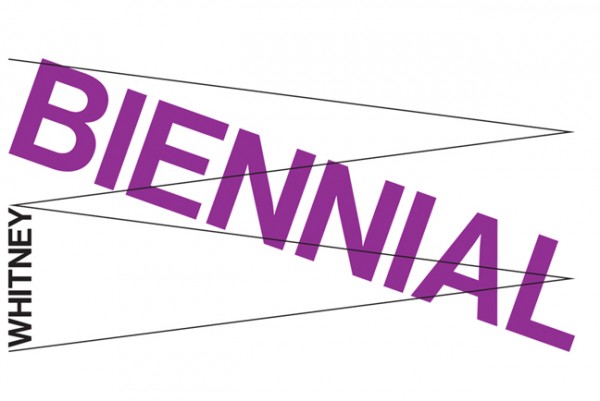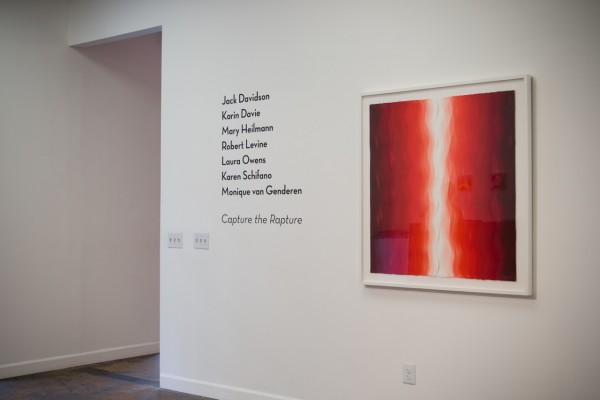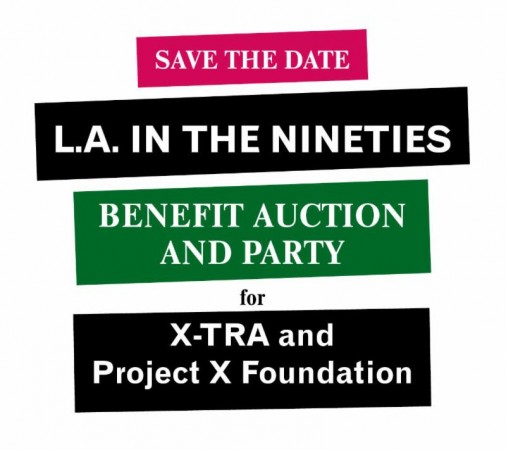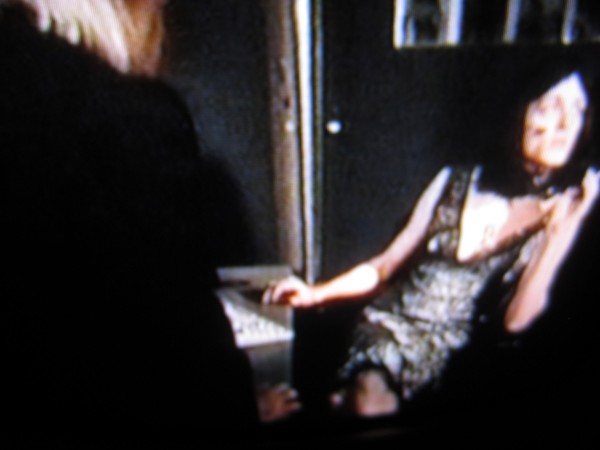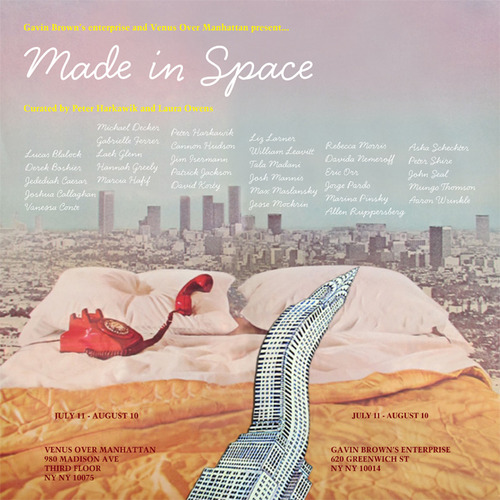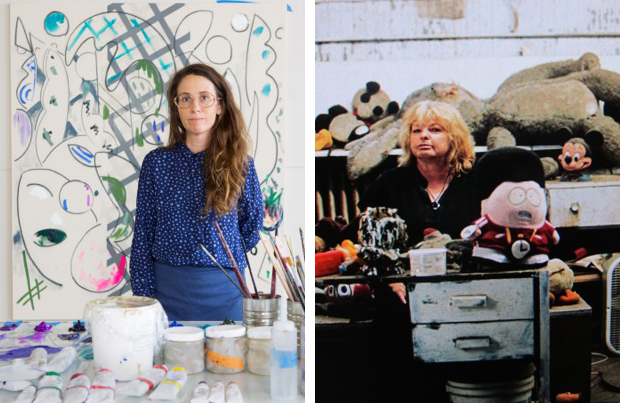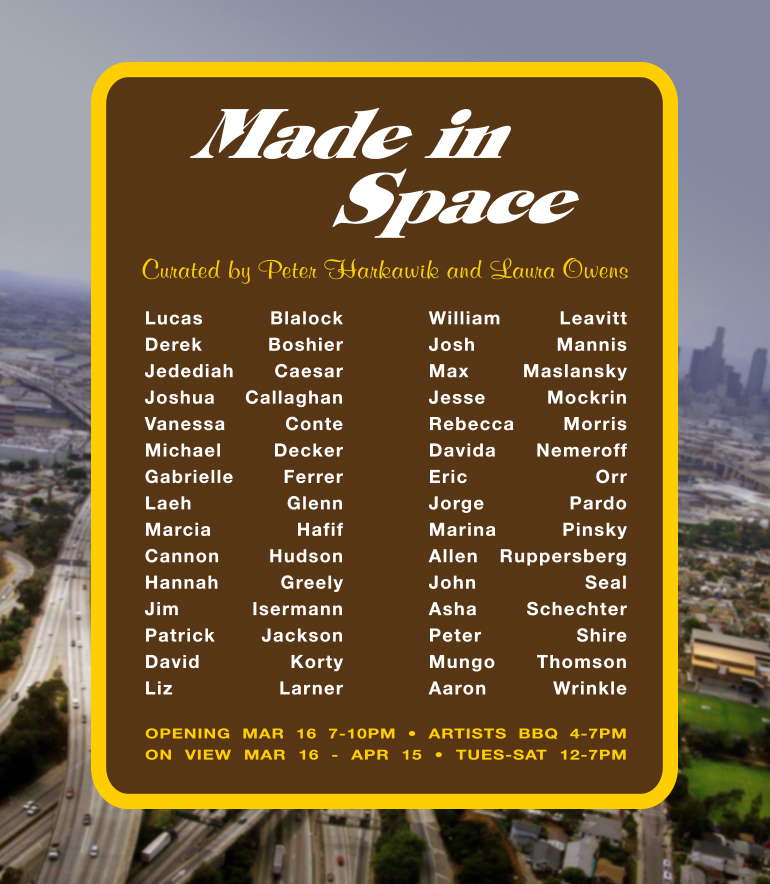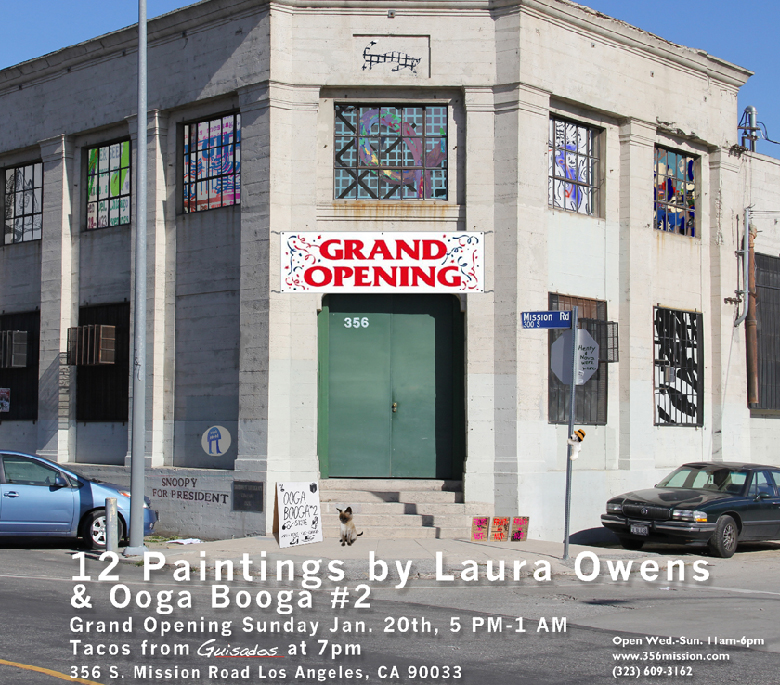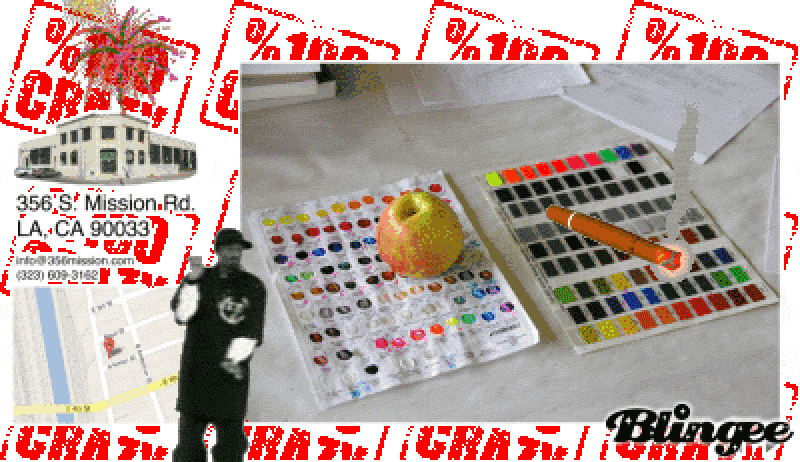“The 2014 Whitney Biennial (March 7 – May 25, 2014) will take a bold new form as three curators from outside the Museum – Stuart Comer (Chief Curator of Media and Performance Art at MoMA), Anthony Elms (Associate Curator at the Institute of Contemporary Art, Philadelphia), and Michelle Grabner (artist and Professor in the Painting and Drawing Department at the School of the Art Institute, Chicago) – each oversee one floor, representing a range of geographic vantages and curatorial methodologies.”
Capture the Rapture
curated by Rory Devine
Participants:
Jack Davidson
Karin Davie
Mary Heilmann
Robert Levine
Laura Owens
Karen Schifano
Monique van Genderen
February 9 – March 16, 2014
Artist Reception: Sunday, February 9, 5 – 7 p.m.
“CB1 Gallery is pleased to present Capture the Rapture, a group painting show curated by gallery artist Rory Devine. With this exhibition, Devine has chosen seven artists whose work he greatly admires, bringing them together to explore different aspects of abstraction. The artists in the exhibition are: Mary Heilmann, Jack Davidson, Karin Davie, Karen Schifano, Laura Owens, Monique van Genderen, and Robert Levine.Capture the Rapture opens on February 9, 2014 and will be on view through March 16, with a reception with the artist on Sunday, February 9, 5 – 7 p.m.”
Feb. 26, 2014
Friday, February 28, 2014 at 7:30 – 11 p.m. at Night Gallery.
Night Gallery
2276 East 16th Street
Los Angeles, CA 90021
Auction site hosted by Paddle 8
Auction preview site and ticket sales
available February 1
40 works available made in LA in the 90s
Artists in Auction:
John Baldessari, Judie Bamber, Stephen Berens, Cindy Bernard, Kaucyila Brooke, Elizabeth Bryant, David Bunn, Ingrid Calame, Miles Coolidge, Eileen Cowin, Meg Cranston, John Divola, Tim Ebner, Charles Gaines, Todd Gray, Jacci Den Hartog, Roger Herman, Steven Hull, Steve Hurd, Jim Isermann, Larry Johnson, Mary Kelly, Martin Kersels, Soo Kim, Liz Larner, Thomas Lawson, William Leavitt, Sharon Lockhart, Dave Muller, Patrick Nickell, Laura Owens, Jennifer Pastor, Renée Petropoulos, Stephen Prina, Ross Rudel, Ed Ruscha, Connie Samaras, Susan Silton, Alex Slade, Brian Tucker, Marnie Weber, James Welling, Robert Wilhite.
For Inquiries contact editors@x-traonline.org
or visit X-TRAonline.org
Jan. 16, 2014
PTG: Abstraction since 1980 at the Guggenheim
Friday, January 17, 2014 at 2 p.m.
“In a series of short talks and discussions, international scholars, curators, and artists address questions of painting and abstraction from the 1980s to the present. Presentations will be given by Suzanne Hudson, Mark Godfrey, and Katy Siegel, in addition to a conversation amongst distinguished curators, moderated by Guggenheim Senior Curator Jeffrey Weiss. The program concludes with an artist conversation featuring Laura Owens, Richard Prince, R.H. Quaytman, and Christopher Wool moderated by exhibition curator Katherine Brinson. An exhibition viewing follows.”
Organized by Katherine Brinson and Suzanne Hudson.
Participants:
Katherine Brinson is Associate Curator at the Solomon R. Guggenheim Museum and exhibition curator of Christopher Wool.
Nicholas Cullinan is Curator of Modern and Contemporary Art at the Metropolitan Museum of Art.
Mark Godfrey is Curator of International Art at Tate Modern in London.
Ann Goldstein is former Director of the Stedelijk Museum Amsterdam.
Suzanne Hudson is Assistant Professor of Modern and Contemporary Art at the University of Southern California.
Laura Owens (b. 1970, Euclid) lives and works in Los Angeles.
Richard Prince (b. 1949, Panama Canal Zone) lives and works in upstate New York.
R.H. Quaytman (b. 1961, Boston) lives and works in New York City.
Scott Rothkopf is Curator and Associate Director of Programs at the Whitney Museum of American Art.
Katy Siegel is Professor of Art History at Hunter College and Chief Curator at Hunter College Galleries at City University New York (CUNY).
Jeffrey Weiss is Senior Curator at the Solomon R. Guggenheim Museum.
Christopher Wool (b. 1955, Chicago) lives and works in New York City and Marfa, Texas.
Jan. 16, 2014
Scab Glam, AnitRa Menning, 1999
Selections from the Venice Beach Biennial:
Echo Park Film Center, Saturday August 31, 2013: 8PM $5
1200 N Alvarado, LA CA 90026
Celebrate the end of summer with an evening of films by:
Margo Victor, Dave Tucker, Haruko Tanaka, Joe Sola, Isabell Spengler, Laura Owens
AnitRa Menning, Laida Lertxundi, Seema Kapur, Tuni Chatterji, Kate Brown and the 99C Chef.
Curated by Kate Brown and Monique van Genderen
Aug. 28, 2013
Made in Space
MADE IN SPACE
Curated by
Peter Harkawik & Laura Owens
July 11 – August 10, 2013
Opening: July 11, 2013 / 6–9 PM
Lucas Blalock, Derek Boshier, Jedediah Caesar, Joshua Callaghan, Vanessa Conte, Michael Decker, Gabrielle Ferrer, Laeh Glenn, Hannah Greely, Marcia Hafif, Peter Harkawik, Cannon Hudson, Jim Isermann, Patrick Jackson, David Korty, Liz Larner, William Leavitt, Tala Madani, Josh Mannis, Max Maslansky, Jesse Mockrin, Rebecca Morris, Davida Nemeroff, Eric Orr, Jorge Pardo, Marina Pinsky, Allen Ruppersberg, Asha Schechter, John Seal, Peter Shire, Mungo Thomson, Aaron Wrinkle
Held in conjunction with
Venus Over Manhattan
980 Madison Avenue – 3rd Floor
New York, NY
GBE
620 Greenwich St.
Tu–S / 10–6
After July 8, M–F / 10–6
//
Made in Space
1. Someone drank tea. Someone else felt that a specific kind of taco eaten at a particular
geographic location was like a drug. The spices generated a certain kind of energy, or, perhaps, muscle memory. It was 2012.
2. In 2002, “thoughts mixed and burned with gasoline” turned to Orange County, a web without a spider, The Citadel, Eden-Olympia. The commingling of purposefulness and aimlessness was understood to be the effect of Junkspace.
3. In 1981, Peter Schjeldahl took a trip to Los Angeles and wrote a short essay damning our city to a future of cultural irrelevance, lest it somehow invert each and every one of its unique features. He wrote, “The wishfulness of LA’s citizens is simply explained as the effect of a life that enforces independence to the point of autism. Try to lean on anything or anyone and you’ll fall down[…] Los Angeles is a city without public spaces. There are only private spaces—fenced haciendas of self-maintenance and self-invention—surrounded with the soft, dreamy, zinging-withlight nowhere in particular.” Much as Michael Fried’s write-off of minimalism as theater, Schjeldahl missed the point.
4. Participants in the 2010 TV series “Wipe Out” drove to Magic Mountain for jouissance: that is, being battered around by brightly colored, slowly rotating foam shapes.
5. In 1986, a pedestrian observed a pair of giant steel springs rolling down the sidewalk near the corner of Wilshire and La Brea. Elsewhere, aphasiacs watched Ronald Reagan on television and were not fooled by his affect. Because they lacked the ability to understand the intended significance of various facial expressions and/or gestures, their experience of his speech was divorced from his image, rendering it as inert and senseless as the printed word.
6. A shopper walks the isles of Home Depot in a stupor, hopelessly trying to assemble a mental list of life goals by way of immediate hardware purchases. Thoughts turn to the specific alienated labor that produced this situation. Is a kindred soul, another loser, in a cubicle somewhere, proliferating this amalgamation of thoughtless spatial constructs, endcap displays stacked to the sky? Is that person horny? Do they have a gaping flesh wound? A fixed quantity of gasoline was converted to smog today. It is 1999.
7. The Mall of America is constructed in 1992. The FDA urges surgeons to abandon silicone in breast implants and the first McDonald’s franchise is opened in China. In the words of French anthropologist Marc Augé, “Place and non-place are rather like opposed polarities: the first is never completely erased, the second never totally completed; they are like palimpsests on which the scrambled game of identity and relations is ceaselessly rewritten.”
8. Food is a variety of colors. We all eat food. Certain foods appear one color or another on
account of food dye. Regardless of whether or not their color is a lie or we willingly suspend
disbelief (as in the instance of a Starburst — is it the flavor “Lemon” or the flavor “Yellow”?), we all eat, and we all shit. In painting, mixing color is a complicated process involving the opacity of various pigments and substrates. Mixing too many colors results in a sludge that is invariably described as “muddy.” This is much like our digestive system. Foods we eat are broken down by procedures which work in concert; the enzymes in our mouth, the acids of our stomach. The color in foods is combined slowly in our body, until we shit, and see the result of our gastric color mixing: brown. In 2009, The Wrigley Company discontinued their unpopular “Baja California” Starburst flavor.
9. A person discovered a pile of feces directly in the middle of a pair of women’s size 10 red pumps. The distance between the shoes and the feces, which looked very much like a chocolatedipped frozen yogurt dessert, or a dog chew, indicated that the person could have been squatting and defecating. This tableau vivant was found in a parking lot behind a chinese restaurant in Beverly Hills in 2008. Every transaction leaves a remainder.
10. In 2001, an auto dealership on the 134 Freeway decided to expand its advertising by taking over an adjacent parking garage. Mannequins, waving and smiling, some posed with balloons, were installed on its upper levels. This visuality of the frontal, of the fleeting glance, produced a sensation not unlike V-effekt in passing drivers. Like a Brechtian stage play, their collective event was stripped of its self-evident nature. That same year, Elizabeth Grosz wrote, “Space, […] outside the ruses of imagination, is not static, fixed, infinitely expandable, infinitely divisible, concrete, extended, continuous, and homogenous, though perhaps we must think in these terms to continue our everyday lives (and the architect is perhaps more invested in this understanding of space than anyone else). Space, like time, is emergence and eruption, oriented not to the ordered, the controlled, the static, but to the event, to movement or action.”
11. In 1993, someone sat in a recliner in Long Beach with a VHS deck balanced on each knee. One screen played Hitchcock’s “Rope” while the other played Altman’s “Short Cuts.” Nearby, under a bridge, someone was feeling like his only companion was the city he lived in, the City of Angels. Around the same time, a wallet was left in El Segundo.
12. Two friends, both architects, drove to Brentwood in 1994. They got out of their car and ran alongside OJ Simpson’s Bronco, hoping to catch a glimpse of reality in progress and joining thousands of people on the streets and overpasses in communal euphoria.
13. Two curators drove by a flip flop in the road. This was mutually lauded for its demonstrative effect. It was 2013.
Jul. 4, 2013
Artist on Artist: Laura Owens on Joyce Pensato
Santa Monica Museum of Art
MONDAY, JUN 3, 2013 7:30PM–8:30PM
Free
“Walkthrough Joyce Pensato: I KILLED KENNY with acclaimed Los Angeles painter Laura Owens and Pensato herself. This auspicious exhibition tour will offer new insights about painting and an intimate look at Pensato’s singular lifework. Limited space available, RSVP to secure your place.”
May. 14, 2013
Made in Space
Made in Space
Curated by Peter Harkawik and Laura Owens
MAR 16 – APR 15, Opens 4-10PM MAR 16
Lucas Blalock, Derek Boshier, Joshua Callaghan, Jedediah Ceasar, Vanessa Conte, Josh Mannis, Michael Decker, Gabrielle Ferrer, Marcia Hafif, Leah Glenn, Cannon Hudson, Hannah Greely, Jim Isermann. Patrick Jackson, David Korty, Liz Larner, William Leavitt, Max Maslansky, Jesse Mockrin, Rebecca Morris, Jorge Pardo, Davida Nemeroff, Eric Orr, Allen Rupersberg, Marina Pinksy, Asha Schechter, Peter Shire, John Seal, Mungo Thompson, Aaron Wrinkle
2276 E 16th St.
Los Angeles, CA 90021
Mar. 12, 2013
12 Paintings by Laura Owens
12 Paintings by Laura Owens
Studio doors open Sunday January 20th, 5pm-1am
356 South Mission Road Los Angeles, CA90033
Open Wed.-Sun. 11am-6pm
(323) 609-3162
